
In this article
Quick takeaways
- For startups and small businesses, manual leave-tracking methods, like spreadsheets, are a drain on time and money. Dedicated software is now essential, not just a ‘nice to have’.
- A modern staff holiday planner helps you stay legally compliant without the financial burden of a full HR suite. This increases productivity by automating administrative tasks and boosts employee morale through transparency and spotlighting wellbeing.
- Leave Dates is the top pick for UK small businesses, balancing user-friendliness, affordability (with a 30-day free trial), and powerful features that have instant impact.
If there’s one thing common to all small businesses, it’s that resources are limited.
Whether you’re cash-strapped, time-poor, under-staffed or all three, you’ll no doubt be trying to do more with less. While we can’t conjure up people or piles of cash from thin air, time is one thing we might be able to help you find a bit more of.
Why small businesses need smart holiday planning
In SMEs you often find people wearing multiple hats, taking on tasks and duties outside of their core role or area of expertise. While this kind of cross-skilling and pitching-in is great for morale and making sure everyone understands the company and ops inside out, it can mean old-fashioned and inefficient methods slipping into use here and there. For example, when it comes to leave requests, while a big corporation likely has an HR department with complex HR software, a small business may have an owner-manager spending a couple of hours a week attending to it all on a spreadsheet. Many small business owners, in their struggle for time, don’t realise that there is a high-performing solution for tracking leave that is affordable and saves time – a digital staff holiday planner.
Manual leave tracking is boring, confusing, highly error-prone and a massive drain on productivity. It is not an area where spending more time translates to a better outcome. It simply has to be done, done accurately, and in compliance with the robust UK labour laws governing holiday pay, sick leave and other statutory entitlements. This is one place where you can be confident you’ll lose nothing by delegating to tech. This is about up to date info, solid systems and data crunching – it’s not the ‘human’ part of human resources. People can make mistakes; set up correctly, software doesn’t. In small businesses, people’s time and attention should be reserved for top priority tasks – the things that need human insight and creativity or that only be done (or done best) manually.
In this context, a smart staff holiday planner is no longer a ‘nice to have’, it’s essential for ensuring a high level of efficiency, transparency and compliance without a high HR staff bill. In this guide, we’ll explore the key features that a small business should be looking for in a staff holiday planner, as well as our top picks.
Key features
What to look for in a staff holiday planner
To get maximum efficiency – and value – out of a leave management tool, a small business should be on the lookout for a few key features:
- Ease of use: You want an intuitive interface and super simple software that anyone can use it, with minimal training. Complexity defeats the object of automation.
- Affordability and scalability: A solution with a transparent per-user pricing model, growing alongside you with no big jumps in cost. Ideally, there’ll be a free trial, allowing you to spend on people before you spend on tech.
- Leave tracking and allowance management: This is core functionality, the ‘work’ you’re getting the system to do for you. It has to accurately calculate and track a range of leave types, from statutory (sick leave, annual leave, maternity/paternity) to custom options perhaps unique to your industry or business. It should also be able to sort out any pro rata adjustments for leavers and starters.
- Visual overview: The new wall chart! Except this one is a digital rather than an office wall. As well as transparency – everyone can see it, at any time – this gives you instant oversight, with a visual display of your staffing levels. This helps you to plan ahead and means you can spot a clash before it happens.
- Remote accessibility: With WFH the new norm and a smartphone in everyone’s pocket, it’s not a big ask to be able to request/approve leave from an app on your phone. The app should be compatible with iOS and Android to suit everyone on your team.
- Calendar integration: Managing multiple systems can be challenging, and constantly switching between screens or duplicating information can lead to mistakes. Your holiday planner should seamlessly sync with other common and popular comms and productivity tools (eg Slack, Outlook, Google Calendar etc) so that nothing falls into a digital black hole.
- Customisation: New types of leave are popping up all the time as employers seek to attract talent and create policy that reflects their people’s genuine wants and needs. Your planner should be as unique as your business.
- Reporting & insights: Data is gold. Your software should be able to produce insightful and relevant reports at the click of a button. This keeps you compliant while also providing a clear picture of absences across the company, which can inform your policy and planning decisions.
- Data security: Your chosen system must keep sensitive employee data secure in line with GDPR. In the UK, it is ideal if the system you use has Cyber Essentials certification also.
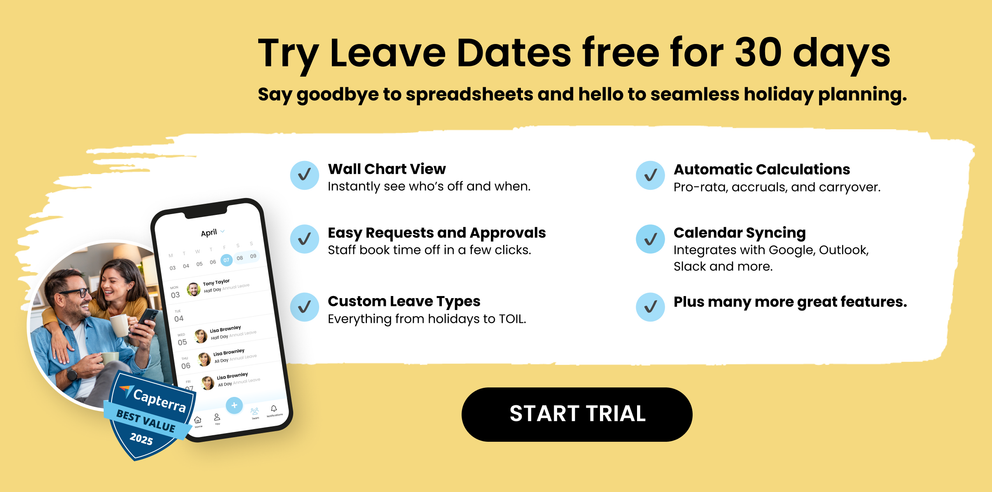
Our top picks
There are a lot of leave management software options out there, and a few great ones. To save you from overwhelm, we’ve sorted the wheat from the chaff to give you our top choices for 2025. We’ve focused on ease of use, top features for small teams and best value for money – key priorities for small businesses.
Best for Scalable Startups
No surprises here but Leave Dates really is the go-to specialist tool for UK small businesses needing a staff holiday planner. Offering an unbeatable combo of user-friendliness, powerful features and affordability – with three flexible plans and an all-important 30-day free trial for new customers – it saves you time and money from day one.
See leave clearly for better planning
The Wall Chart is an all-time customer favourite, giving you a vibrant overview of absences in real-time. It is easy to see who’s in and who’s out and if there is a scheduling clash on the horizon. Booking leave using the wall chart on desktop is simple – just click and drag over the dates and leave form will pop up with the requested dates pre-filled.
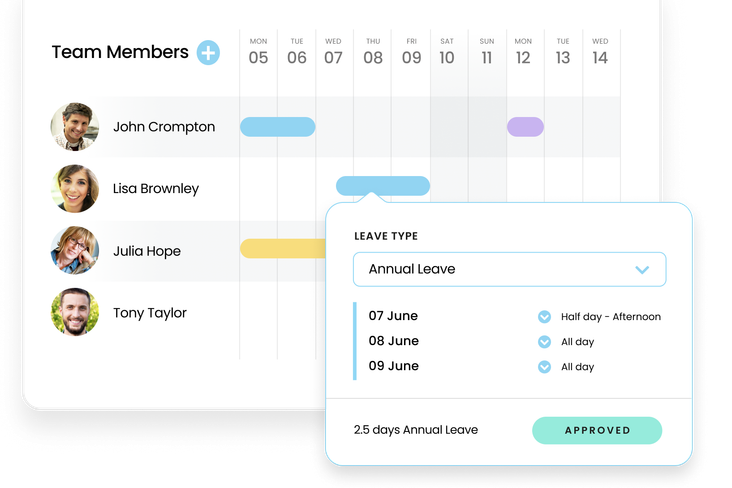
Time-saving automations and integrations.
Leave Dates does all the heavy lifting from behind the scenes by calculating leave balances, pro-rata adjustments, carry-over, TOIL and more. It syncs with Slack, Outlook and Google Calendar seamlessly and includes API, Zapier and Webhook options so you can customise your integrations. Forget doing math or missing updates, everything just works.
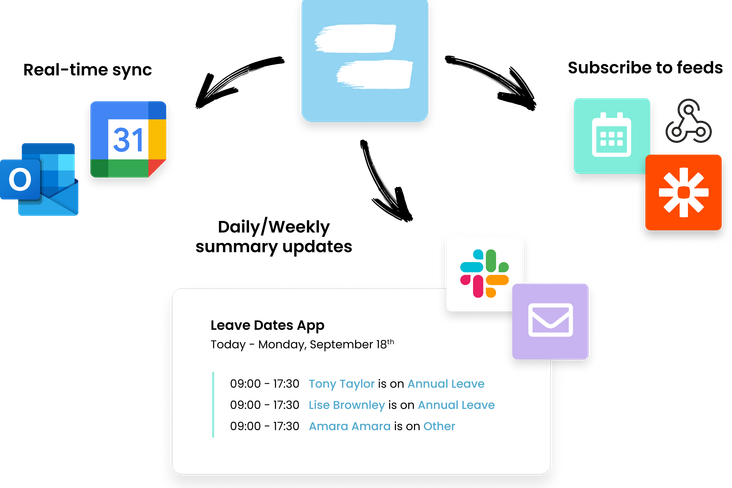
Hassle-free customisation and reporting.
Another big win is the customisability – add as many custom leave types as you like – and simple user interface with mobile app, so you won’t have a hard time getting staff to use it. Managers love it too, with robust tools making reporting a breeze.
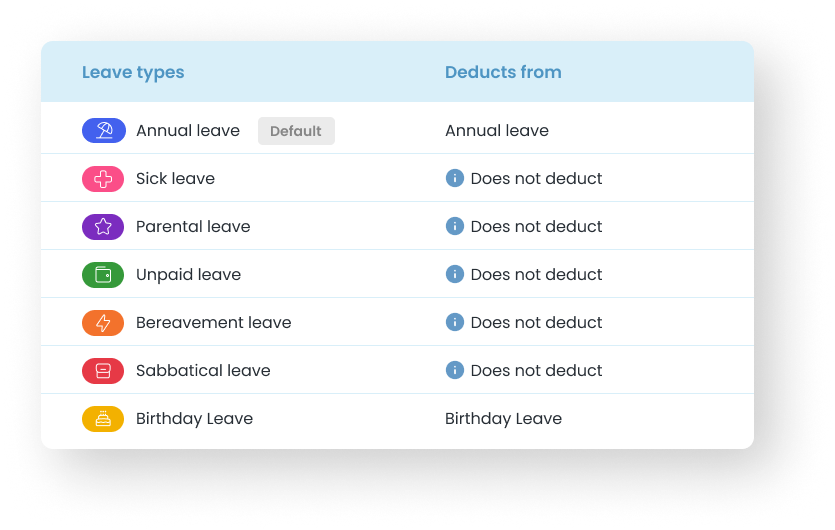
Using Leave Dates reporting tools, you can easily spot patterns in your leave data. Spot when someone is getting close to burnout, if you get a bottleneck of leave requests at certain times of year. You can use that data to create good policies and customise your account further.
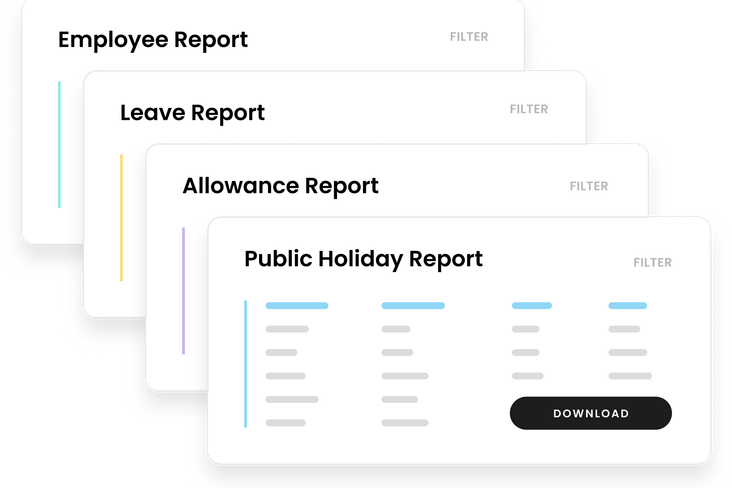
Best Spreadsheet Planner
Let’s look at how you can use a free staff holiday tracker like a Google Sheet for your leave admin. We will use our downloadable Google Sheet as our example.
This spreadsheet gives you a clear view of who is off and when, without needing to start the process of designing it from scratch. The calendar-style layout lets you list employees (with examples to get you started) and allows you to switch month and year view using a dropdown menu.
Using this spreadsheet, you can record different types of statutory leave, whether it be annual leave, sick leave, parental leave, etc. But if your company has its own policies, like birthday leave, duvet days or wellbeing leave, you will need to customise it yourself to ensure they are tracked.
Using a spreadsheet, you will need to do some extra admin and confirm existing schedules, allowances, leave balances and update your Google Sheet and other records leave accordingly. The Google Sheet is a great way to keep a quick central record, but keeping everything up-to-date can cause an admin bottleneck.
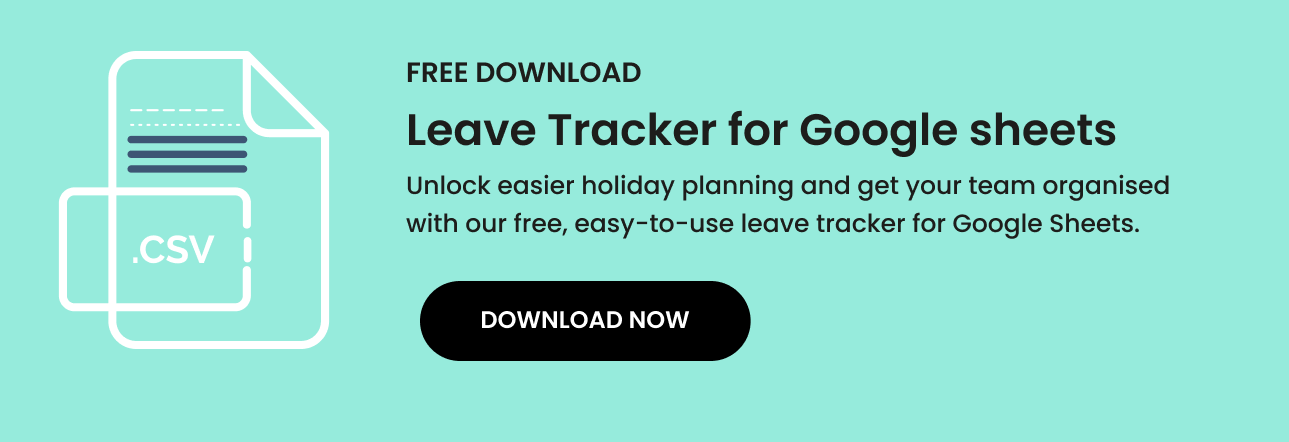
Despite the advantages of the Google Sheet leave tracker being free to use, and quite intuitive for a spreadsheet, there are some limitations to note:
- It cannot process leave requests, so you will have to rely on good and streamlined communication from your team via text, email, even Slack.
- Manual updating will be required in multiple spots, and if someone books leave and cancels, you will need to remember to update the sheet with reference to the written cancellation email.
- Your record of leave allowances and balances will need to be recalculated and manually updated also.
- Pro-rata, accruals, or carryover from the previous year will need to be manually calculated.
- Reporting is limited using this method.
Customer story: Word Monster’s early transition from spreadsheet stress to simple software
The Word Monster team was hiring their second staff member when Dr Carl Owen, founder, felt it was time to abandon his leave spreadsheet. The spreadsheet worked for a short while, but as requests began overlapping, Carl was struggling to keep up with emails, manually checking and adjusting balances and stressing about overlap. He describes the manual system as “overwhelming quite early for the business and individuals keeping their own track.”
After switching to Leave Dates, Carl’s team had a simple, scalable solution that was easy for everybody to use. The team had now grown to over 20 staff members in three countries, and despite using a full HR system for other tasks, they still use Leave Dates as their trusted staff holiday planner. It seems you can have it all.
Best All-in-One HR Suite
BambooHR is an established full HR platform for small to mid-sized companies. Alongside holiday planning, it provides recruitment tools, employee records, performance management, and reporting. In this case, leave management is one part of a larger HR package.
Using BambooHR, employees can request time off directly through the system, and managers can review and approve them - just like Leave Dates. This reduces the burden of manual admin that you face with spreadsheets.
While it makes sense to look at BambooHR for a business that needs a full suite of HR features, there are some limitations that may impact its suitability for small businesses:
Starting at £8.10 per employee, per month, it is considered a premium product. If your team is unable to use features like recruitment pipelines or performance management, the cost of unused features will quickly add up.
Being a full HR suite, there may be some training and education resources that you need to budget for. If you are just looking for simple leave tracking, this system may be more complex than required.
Bamboo HR is less tailored to holiday planning than a dedicated solution like Leave Dates. It may feel less streamlined or customisable..
How to choose the best system for your business
Decisions, decisions. With several great options out there, how do you decide which is the right software for your small business?
Ultimately, it’s a personal decision – you know your business and your specific needs best. While we can’t tell you who to choose; we can help you with how to choose:
- Define your needs – what are your biggest pain points? Are you struggling to get your head around legal compliance? Seeing lots of calendar clashes? Wasting time on admin? This will help you suss out the non-negotiable features – the rest is a bonus, so if it comes at a high cost, think about whether it’s worth that to you.
- Budget – what can you afford? How much do you want to pay? Factor in both one-time/setup costs as well as ongoing subscriptions. Think about the cost of training, if it will be needed, and think ahead – how much will the cost increase when you grow?
- Try it out – most decent providers will offer a free trial, or even a free tier. This is the best way to figure out if a tool is going to fit your workflow. A free trial needs to be at least a month for you to fully explore all its features.
- Customer service – when you have an idea of which software you can afford and that will work for you, the last thing to think about is the support (and maybe even training) on offer. A supplier who is easy to contact, with a good knowledge base and helpful resources, will be worth their weight in gold, enabling you to get up and running quickly and smoothly.
To sum up, switching to a digital staff holiday planner is one of the most effective ways to modernise your small business and free up valuable time. It’s a simple change that should be quick to implement and can have a transformative impact in less admin, more time and an ability to focus on what you’re all really there for.
If you’re ready to see what life looks like when you step away from the paper wall chart, Leave Dates offer a 30-day free trial, which combines ease of use with power and affordability. It’s a tool that grows with you – a future-proof solution for now, and for when your small business isn’t so small anymore.
FAQs
Yes, most modern systems are both cloud-based and include a mobile app. This allows remote and hybrid teams to request and approve leave from anywhere. Using a system like Leave Dates, you can see your team's leave schedule on desktop and mobile, anywhere, anytime.
The best systems are GDPR compliant and use secure servers to store data. In the UK, the most reputable companies also go through a yearly Cyber Essentials certification to ensure that they meet industry standards for security.
Absolutely. The best tools are made for scalability. Whether you have 3 employees or 300, as your team expands, your leave management software can be easy to use and affordable.



